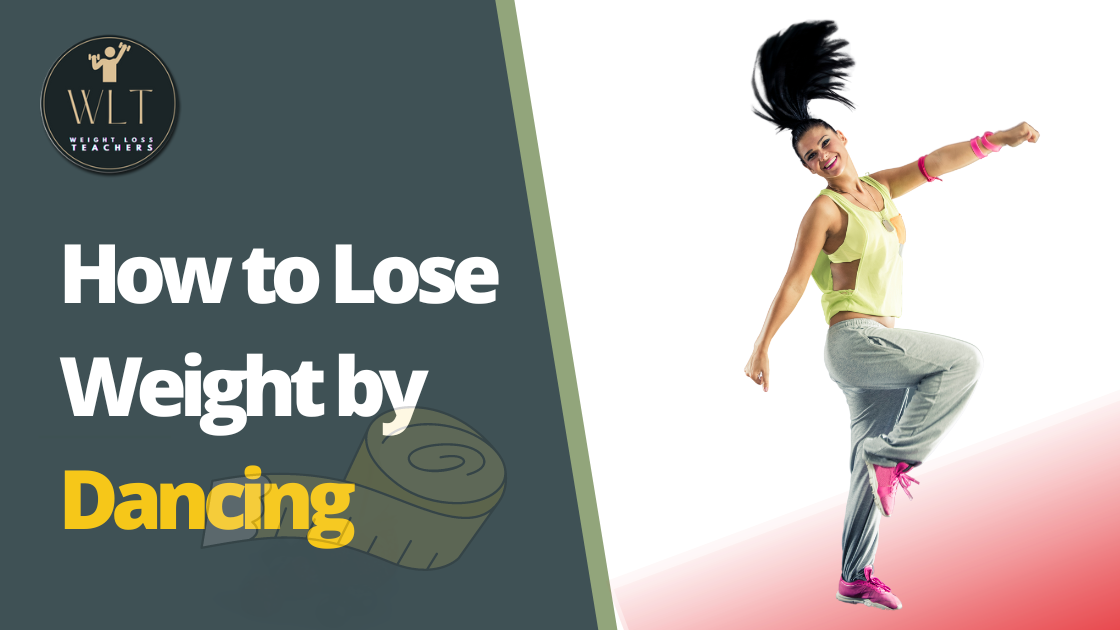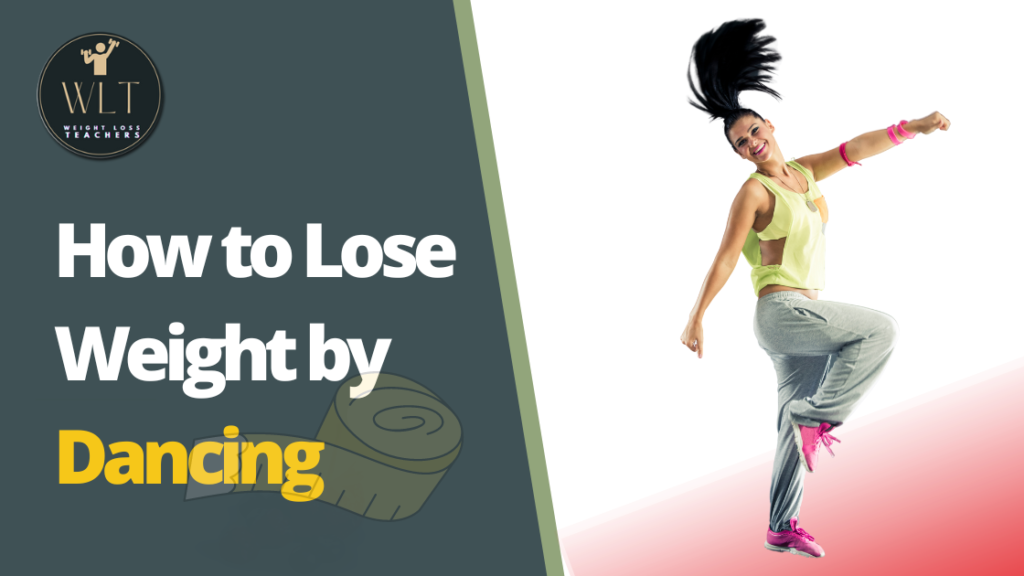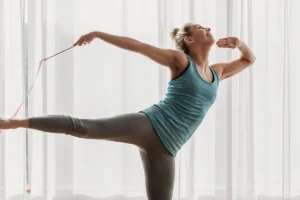
How to Lose Weight by Dancing

Dancing is an enjoyable and effective way to burn calories, tone muscles, and lose weight. It is a full-body workout that can be tailored to suit different fitness levels and styles.
Table of Contents
Introduction
Dancing is an enjoyable and effective way to burn calories, tone muscles, and lose weight. It is a full-body workout that can be tailored to suit different fitness levels and styles. In this article, we will explore how to lose weight by dancing and the benefits of incorporating dance into your weight loss journey.

The Health and Fitness Benefits of Dancing for Weight Loss

Dancing is not just a form of artistic expression; it is also a powerful tool for achieving and maintaining a healthy weight. Whether you’re a seasoned dancer or someone who just likes to let loose on the dance floor occasionally, you may be surprised to learn that dancing offers numerous benefits for weight loss. In this article, we will explore these benefits in depth, delving into how dancing burns calories, tones muscles, improves cardiovascular health, increases flexibility and coordination, and boosts mood. By the end of this discussion, you’ll have a greater appreciation for how dancing can be an enjoyable and effective means of shedding those extra pounds.
Burns Calories
One of the most immediate and obvious benefits of dancing for weight loss is its calorie-burning potential. Dancing is a cardio workout that can torch a significant number of calories. The exact number of calories burned depends on various factors, including the intensity of the dance style and your body weight. However, on average, a person can burn anywhere from 200 to 600 calories per hour while dancing.
The calorie-burning aspect of dancing makes it an excellent choice for those looking to shed pounds. Compared to many other forms of exercise, dancing offers a unique combination of physical activity and entertainment, making it easier to stick to a regular exercise routine. Whether you’re grooving to your favorite tunes in a dance class, hitting the club on the weekend, or even just dancing around your living room, you’re actively contributing to your calorie deficit, which is essential for weight loss.
Tones Muscles
Weight loss isn’t just about shedding fat; it’s also about sculpting a lean and toned body. Dancing is a full-body workout that engages multiple muscle groups simultaneously. Different dance styles emphasize different muscle groups, which mean that you can choose a dance style that aligns with your fitness goals.
For example, ballet can help tone your legs and core, while salsa or hip-hop dancing can work your legs, glutes, and upper body. The constant movement, lifts, and controlled motions involved in dancing help to build and strengthen muscles, resulting in a more defined and sculpted physique.
Additionally, dancing incorporates isometric contractions, where muscles remain contracted while lengthening, leading to improved muscle endurance and flexibility. The combination of calorie burning and muscle toning makes dancing a well-rounded approach to achieving your weight loss and fitness goals.
Improves Cardiovascular Health
Beyond its weight loss benefits, dancing is a fantastic way to enhance your cardiovascular health. Cardiovascular exercise, such as dancing, raises your heart rate and improves the efficiency of your heart and lungs. Regular cardiovascular exercise can lower the risk of heart disease, reduce high blood pressure, and improve overall heart health.
When you engage in a dance session, whether it’s a high-energy Zumba class or a graceful waltz, you’re essentially giving your cardiovascular system a workout. Your heart pumps blood more efficiently, your lungs take in more oxygen, and your body becomes better at delivering oxygen to your muscles. Over time, this can lead to a lower resting heart rate, improved circulation, and a reduced risk of heart-related problems.
Increases Flexibility and Coordination
Flexibility and coordination are often overlooked but crucial aspects of fitness and weight loss. Dancing requires a wide range of motion and demands precise coordination between various body parts. As you learn different dance moves and routines, you gradually improve your flexibility and coordination, which can have several benefits.
Improved flexibility can help prevent injuries and muscle imbalances, allowing you to engage in physical activities more safely and effectively. Moreover, enhanced coordination and balance can reduce the risk of falls, especially as you age. This is particularly important because falls can lead to injuries that may hinder your weight loss progress.
Boosts Mood

Weight loss journeys can be challenging, and maintaining a positive mindset is crucial for long-term success. Dancing offers a unique advantage in this regard as it is not just a physical activity but also a form of self-expression and creativity. When you dance, your body releases endorphins, which are natural mood boosters that help reduce stress and anxiety.
The sheer enjoyment of dancing can elevate your mood, making it easier to stay motivated and committed to your weight loss goals. Unlike some other exercise routines that may feel like a chore, dancing is a joyful activity that allows you to let loose, have fun, and forget about the stresses of daily life.
Dancing Your Way to Weight Loss: Tips for Success

Weight loss can be a challenging journey, but it doesn’t have to be dull or monotonous. If you’re looking to shed those extra pounds while having a blast, dancing may be the answer. Dancing is not only an enjoyable and expressive art form but also a fantastic way to burn calories and improve your fitness. In this article, we’ll explore how to lose weight by dancing, offering practical tips to help you get started and stay motivated on your dance-inspired weight loss journey.
Choose the Right Style
Dancing for weight loss begins with selecting the right dance style. There’s a wide variety of dance styles to choose from, each offering a unique experience. It’s essential to pick a style that you genuinely enjoy and one that aligns with your current fitness level.
If you’re new to dancing or prefer a low-impact approach, consider styles like ballroom, salsa, or even line dancing. These styles offer a great introduction to dance, helping you build coordination and confidence. On the other hand, if you’re more adventurous and have some experience, high-energy styles like hip-hop, Zumba, or contemporary dance can provide an intense workout while keeping things exciting.
Choosing the right style ensures that you look forward to your dance sessions, making it easier to stay committed to your weight loss goals.
Set a Clear Goal
To embark on a successful weight loss journey through dancing, it’s crucial to set specific and achievable goals. Your goals should include both a target weight or body composition and a timeline for achieving them. Having clear objectives will help you stay motivated and provide a sense of direction.
When setting your goals, be realistic and consider your current fitness level. Gradual, sustainable weight loss is often more effective and healthier in the long run than rapid, extreme measures. Remember that dancing is not only about losing weight but also about improving your overall fitness, coordination, and mental well-being.
Incorporate Dance into Your Routine
Consistency is key when it comes to losing weight through dancing. Incorporate dance into your daily routine to ensure that it becomes a habit. You can do this by:
- Taking dance classes: Joining a dance class, whether it’s at a local studio or online, provides structure and accountability. Regular classes will help you refine your skills and stay on track with your weight loss goals.
- Dancing at home: If you prefer privacy or have a busy schedule, dancing at home is a convenient option. Create a dedicated space where you can move freely, play your favorite music, and dance for at least 30 minutes a day. Many online dance tutorials are available to guide you.
- Dance breaks: Take advantage of small pockets of time throughout your day to get moving. Short dance breaks can be refreshing and help you accumulate your daily dance minutes.
Increase Intensity Gradually
As you become more comfortable with dancing, it’s essential to gradually increase the intensity of your dance sessions. This can be achieved by:
- Adding challenging moves: Progressively incorporate more complex dance moves into your routines. This not only makes your sessions more exciting but also boosts calorie burn and muscle engagement.
- Extending duration: Gradually extend the duration of your dance sessions. Aim to dance for longer periods or include multiple dance sessions in your day, if possible.
- Interval training: Incorporate intervals of higher intensity dancing, such as fast-paced routines, followed by short recovery periods. Interval training can significantly elevate your heart rate and calorie expenditure.
Combine with Other Exercises

While dancing is an excellent way to lose weight, it’s even more effective when combined with other forms of exercise. To maximize your weight loss potential, consider incorporating the following into your routine:
- Strength training: Building lean muscle mass through strength training can boost your metabolism, helping you burn more calories even at rest. Consider adding resistance exercises like weightlifting or bodyweight workouts to your weekly routine.
- Cardio workouts: Incorporate cardiovascular workouts like running, swimming, or cycling to complement your dance sessions. This variety keeps your workouts interesting and provides a comprehensive fitness regimen.
- Flexibility and stretching: Don’t forget the importance of flexibility and stretching exercises to prevent injury and improve your dance performance.
The Dance Styles that Will Help You Shed Pounds

When it comes to losing weight, the key is to find an exercise routine that not only burns calories but also keeps you engaged and motivated. Dancing is one such activity that offers a perfect blend of fitness and fun. Not all dance styles are created equal when it comes to weight loss, though. In this article, we’ll explore some of the best dance styles for weight loss, each offering its unique mix of calorie-burning potential and body-toning benefits. Whether you’re into Latin rhythms, hip-hop beats, graceful ballet, or more, there’s a dance style to suit your fitness goals.
Zumba: The Latin Fiesta
Zumba is often celebrated as the ultimate dance fitness party, and for a good reason. This high-energy dance workout blends Latin rhythms like salsa, merengue, and cumbia with cardiovascular exercise. Zumba sessions are a dynamic and exhilarating way to torch calories while having a blast. On average, an hour of Zumba can burn up to 500 calories, making it an efficient way to support your weight loss goals.
What sets Zumba apart is its inclusivity. It’s suitable for all fitness levels, from beginners to advanced dancers. The choreography is designed to be easy to follow, allowing you to immerse yourself in the music and rhythm without feeling overwhelmed. This dance style encourages full-body movement, engaging your legs, core, and arms, which ultimately helps with muscle toning.
If you’re looking for a joyful and social way to shed those extra pounds, Zumba classes at your local gym or online may be the perfect fit for you.
Hip Hop: Groove Your Way to Fitness
Hip hop is a high-energy dance style that has taken the world by storm. Known for its fast-paced movements, intricate footwork, and expressive flair, hip hop dancing offers an intense workout that can burn up to 400 calories per hour. What’s more, it’s fantastic for toning muscles, especially in the legs and core.
The essence of hip hop lies in its rhythmic and powerful choreography, which encourages agility, coordination, and endurance. As you move to the beats of hip hop music, you’ll find yourself building strength and stamina. The constant shifts between explosive bursts of energy and controlled movements also contribute to increased calorie expenditure.
Hip hop is perfect for those who crave a more urban and contemporary dance style. Many dance studios and online platforms offer hip hop classes catering to various skill levels, making it accessible to both beginners and experienced dancers.
Jazzercise: Fusion of Dance and Fitness
Jazzercise is a dance-based workout that combines elements of jazz dance, resistance training, and Pilates. Developed in the 1960s, it has evolved into a modern fitness phenomenon, offering a full-body workout while incorporating dance movements. Jazzercise classes are known to burn up to 600 calories per hour, making it one of the most calorie-intensive dance styles on this list.
This style is designed to challenge your cardiovascular system, strengthen your muscles, and improve flexibility—all within a fun and vibrant atmosphere. Jazzercise routines often include a mix of dance steps, strength training exercises, and core-focused movements. The incorporation of hand weights or resistance bands adds an extra layer of muscle engagement.
The variety within Jazzercise classes ensures that your body never gets used to the same routine, preventing fitness plateaus and keeping your weight loss journey exciting. Look for Jazzercise classes at local fitness centers or explore online options to join in the fitness and dance fusion fun.
Ballet: Graceful Weight Loss
While ballet may not be as high-impact as some other dance styles, it offers unique benefits for weight loss. This classical dance style emphasizes control, balance, and precision, making it an excellent choice for those seeking a low-impact workout that enhances flexibility and tones muscles. Ballet can burn around 300 calories per hour, depending on the intensity and duration of the session.
Ballet focuses on elongating and strengthening the body’s core muscles, including the legs, glutes, and abdominals. The graceful and controlled movements promote good posture, which can be especially helpful if you spend long hours sitting at a desk. Ballet also encourages mindfulness, as it requires concentration and mental discipline.
If you’ve always been fascinated by the elegance of ballet and want to experience its weight loss benefits, consider enrolling in adult ballet classes offered at many dance studios. It’s an excellent way to embrace the artistry and athleticism of this timeless dance form while achieving your fitness goals.
Salsa: Spicy and Energetic
Salsa is a Latin dance style that brings the heat both on and off the dance floor. It’s a fun and energetic dance style known for its fast footwork, hip movements, and vibrant music. Salsa can burn up to 400 calories per hour, making it a fantastic choice for those looking to shed pounds while improving coordination and cardiovascular health.
What makes salsa special is its emphasis on social dancing. Partnering up with someone adds an element of connection and fun, making it a social activity as well as a workout. Salsa dancing involves quick changes in direction, twists, and turns, which challenge your balance and engage your core muscles.
Dancing salsa regularly can improve your agility and rhythm, helping you become a more confident and skilled dancer. Many cities have salsa clubs or dance studios offering salsa classes, so you can easily immerse yourself in this lively and passionate dance style.
Dance Your Way to Successful Weight Loss: Tips for a Slimmer, Healthier You

Weight loss journeys can be both challenging and rewarding, and incorporating dance into your fitness routine can make the process enjoyable and effective. Dancing not only burns calories but also uplifts your mood and boosts your overall fitness. To make your weight loss by dancing endeavor successful, it’s crucial to follow some essential guidelines. In this article, we’ll delve into tips for successful weight loss through dancing, including warming up and cooling down, wearing appropriate footwear, staying hydrated, listening to your body, prioritizing rest, maintaining a healthy diet, and embracing consistency.
Warm-Up and Cool Down: Protecting Your Body
Before you start dancing vigorously, it’s essential to warm up your body properly. Warming up gradually increases your heart rate, warms up your muscles, and prepares your joints for more intense movement. This reduces the risk of injury and ensures that you get the most out of your dance workout.
A proper warm-up for dancing can include light cardio exercises like jogging in place or jumping jacks to get your heart rate up. Additionally, you can perform dynamic stretches that target the muscles you’ll be using during your dance routine. For example, leg swings, arm circles, and hip rotations can help loosen up your joints and muscles.
After your dance session, cooling down is equally important. It helps your body gradually return to a resting state and prevents post-workout muscle soreness. Spend a few minutes doing static stretches to maintain flexibility and aid in muscle recovery. Focus on the major muscle groups you used during your dance workout, such as your legs, arms, and back.
By incorporating warm-ups and cool-downs into your dance routine, you not only protect your body from potential injuries but also improve your flexibility over time, enhancing your dancing skills.
Wear Appropriate Footwear: Dance with Confidence
The right footwear is essential for a successful dance workout. Wearing appropriate shoes ensures not only your comfort but also your safety and performance. Different dance styles require different types of footwear, so it’s essential to choose the right pair.
For high-impact styles like hip hop or Zumba, cross-training or dance sneakers with good cushioning and ankle support are ideal. These shoes provide stability, shock absorption, and flexibility for dynamic dance movements.
For low-impact styles like ballet or jazz, specialized dance shoes such as ballet slippers or jazz shoes are recommended. These shoes are designed to allow for precise footwork, balance, and flexibility.
Investing in proper footwear can help prevent injuries and make your dance sessions more enjoyable. Ill-fitting or inadequate shoes can lead to discomfort and even long-term foot problems, so choose wisely to ensure your safety and performance.
Stay Hydrated: Dance with Vitality
Dancing can be an intense workout, and just like any other physical activity, it can lead to dehydration if you’re not careful. Staying hydrated is crucial for your overall health and dance performance. Proper hydration helps regulate body temperature, lubricates joints, and transports nutrients to muscles.
To ensure you’re adequately hydrated, drink water before, during, and after your dance workout. The amount of water you need can vary depending on factors like the intensity of your dance routine, the temperature of your surroundings, and your body’s individual needs. It’s generally recommended to aim for at least eight 8-ounce glasses (about 2 liters) of water daily.
If you’re engaged in a particularly strenuous dance session, you may need to replenish lost electrolytes. Consider sports drinks or coconut water to help maintain the balance of essential minerals like sodium, potassium, and magnesium.
By staying hydrated, you’ll not only improve your dance performance but also reduce the risk of cramps, dizziness, and fatigue during and after your workouts.
Listen to Your Body: Dance Mindfully

One of the most critical aspects of successful weight loss through dancing is listening to your body. Paying attention to how your body feels during your dance sessions is crucial for your safety and overall progress.
If you feel pain or discomfort during a particular movement, it’s essential to modify or skip it to prevent injury. Pain is your body’s way of signaling that something may be wrong. Don’t push yourself too hard or try to keep up with advanced dancers if it puts you at risk of injury. Gradually increase the intensity and duration of your workouts as your fitness level improves.
Moreover, it’s essential to recognize when your body needs rest. Overtraining can lead to burnout, decreased performance, and even injury. Ensure you get adequate sleep and allow your muscles to recover. Aim for 7-8 hours of quality sleep per night and consider incorporating rest days into your weekly routine to give your body the time it needs to repair and rebuild.
Listening to your body also means being mindful of your emotional state. Dancing is not just a physical activity; it’s also a form of self-expression and stress relief. If you’re feeling stressed or overwhelmed, dancing can be an excellent way to unwind and boost your mood.
Eat a Healthy Diet: Fuel Your Dance Workouts
A healthy diet plays a pivotal role in successful weight loss by dancing. What you eat can significantly impact your energy levels, endurance, and overall fitness. To maximize the benefits of your dance workouts, focus on maintaining a balanced diet that includes:
- Fruits and vegetables: These provide essential vitamins, minerals, and fiber to support overall health and recovery.
- Lean protein sources: Protein is crucial for muscle repair and growth. Include options like chicken, fish, lean beef, tofu, or beans in your meals.
- Whole grains: Complex carbohydrates from whole grains like brown rice, quinoa, and whole wheat bread provide sustained energy for your dance sessions.
- Healthy fats: Incorporate sources of healthy fats such as avocados, nuts, seeds, and olive oil to support joint health and overall well-being.
- Hydration: As mentioned earlier, staying well-hydrated is essential. Water should be your primary beverage throughout the day.
Avoid excessive consumption of processed foods, sugary snacks, and high-calorie beverages, as they can hinder your weight loss progress and leave you feeling sluggish.
Stay Consistent: Dance Your Way to Success
Consistency is the key to successful weight loss by dancing. Make dance a regular part of your daily or weekly schedule to see long-lasting results. To maintain consistency:
- Set specific goals: Having clear and achievable goals will give you direction and motivation.
- Create a workout plan: Plan your dance sessions ahead of time, and stick to a regular routine that fits your schedule.
- Find a dance buddy: Dancing with a friend can provide accountability and make your workouts more enjoyable.
- Reward yourself: Celebrate your achievements along the way to stay motivated.
- Embrace variety: Change up your dance style or routine occasionally to prevent boredom and plateaus.
Remember that weight loss is a gradual process, and results may not be immediate. Stay patient and committed to your dance workouts, and over time, you’ll notice positive changes in your body and overall well-being.
Note: There might be affiliate links mentioned here. We may receive a commission if you purchase a product through an affiliate link. There is no additional charge for you. Please do your own research before making any online purchases.
FAQs (frequently Asked Questions)
Q1. How many calories can I burn per hour while dancing?
A1. On average, a person can burn anywhere from 200 to 600 calories per hour while dancing. The exact number depends on factors like the intensity of the dance style and your body weight.
Q2. How does dancing help tone muscles?
A2. Dancing engages multiple muscle groups simultaneously, which can lead to muscle toning. Different dance styles emphasize different muscle groups, allowing you to choose a style that aligns with your fitness goals.
Q3. How does dancing improve cardiovascular health?
A3. Dancing is a form of cardiovascular exercise that raises your heart rate, improves heart and lung efficiency, reduces the risk of heart disease, and lowers blood pressure.
Q4. Can dancing increase flexibility and coordination?
A4. Yes, dancing requires a wide range of motion and demands precise coordination between various body parts. As you learn different dance moves and routines, you gradually improve flexibility and coordination.
Q5. How does dancing boost mood and reduce stress?
A5. Dancing releases endorphins, natural mood boosters that help reduce stress and anxiety. The enjoyment of dancing can also elevate your mood and make it easier to stay motivated on your weight loss journey.
Q6. What is the importance of warming up and cooling down in dance workouts?
A6. Warming up gradually increases your heart rate and prepares your muscles and joints for intense movement, reducing the risk of injury. Cooling down helps your body return to a resting state and prevents post-workout muscle soreness.
Q7. Why is wearing appropriate footwear essential for dancing?
A7. The right footwear ensures comfort, safety, and performance during dance workouts. Different dance styles require different types of shoes, so choosing the right pair is crucial to prevent discomfort and injury.
Q8. How can staying hydrated improve dance performance?
A8. Proper hydration regulates body temperature, lubricates joints, and transports nutrients to muscles, all of which are essential for optimal dance performance. Dehydration can lead to cramps, dizziness, and fatigue.
Q9. Why is listening to your body important during dance workouts?
A9. Listening to your body helps prevent injury and promotes overall progress. It’s crucial to modify or skip movements that cause pain or discomfort. Recognizing when your body needs rest is also essential to prevent overtraining.
Q10. How does maintaining a healthy diet complement weight loss through dancing?
A10. A balanced diet provides the necessary nutrients and energy for dance workouts, ensuring you have the stamina to perform at your best. It also supports muscle recovery and overall well-being during your weight loss journey.
Conclusion
Dancing is a fun and effective way to lose weight, tone muscles, and improve cardiovascular health. By choosing the right dance style, setting a goal, and staying consistent, you can achieve your weight loss goals in a sustainable and enjoyable way. Remember to warm up and cool down, wear appropriate footwear, stay hydrated, listen to your body, get enough rest, eat a healthy diet, and stay consistent. With dedication and perseverance, you can achieve your desired weight loss results through dancing.
Disclaimer: The information provided in this article is for educational purposes only and should not be considered as a substitute for medical advice. Consult a healthcare professional before implementing any home remedies or making significant changes to your lifestyle.






